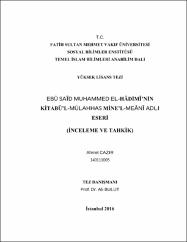| dc.contributor.advisor | Bulut, Ali | |
| dc.contributor.author | Cazır, Ahmet | |
| dc.date.accessioned | 2016-09-20T12:03:53Z | |
| dc.date.available | 2016-09-20T12:03:53Z | |
| dc.date.issued | 2016 | |
| dc.date.submitted | 2016 | |
| dc.identifier.citation | CAZIR, Ahmet, Ebû Saîd Muhammed El-Hâdimî’nin Kitabü’l-Mülahhas Mine’l-Meânî adlı eseri (inceleme ve tahkik), Fatih Sultan Mehmet Vakıf Üniversitesi Sosyal Bilimler Enstitüsü Temel İslam Bilimleri Anabilim Dalı, Yayımlanmamış Yüksek Lisans Tezi, İstanbul 2016 | en_US |
| dc.identifier.uri | https://hdl.handle.net/11352/2382 | |
| dc.description.abstract | Belâgat insanda doğuĢtan var olan bir melekedir. Belâgatın ilim dalı haline gelmesi ise Kur‟ân-ı Kerîm ile baĢlamıĢtır. Ġslâmiyetin yayılmasına paralel olarak Arap olmayanların da Ġslâm‟a girmesiyle Kur‟ân-ı Kerîm‟i anlama ve tebliğ çalıĢmaları çerçevesinde nahiv ve tefsir çalıĢmaları yapılmıĢtır. Âlimler ayetlerin içerdiği teĢbih, mecaz, kinâye gibi edebî sanatlara değinmiĢlerdir. Sonraları bu edebî sanatlar geliĢtirilerek bir takım çalıĢmalar yapılmıĢ, metin ve ya Ģerhten oluĢan müstakil çalıĢmalar yapılmıĢtır.
Osmanlı âlimleri de bu alanda eĢsiz eserler vermiĢlerdir. ÇalıĢmamızın temelini oluĢturan Ebû Said Muhammed el-Hâdimî‟nin Kitâbü‟l-Mülahhas Mine‟l-Meânî adlı eseri de bu çalıĢmalardan biridir.
Eser klasik belâgat eser tarzına uygun olarak meânî, beyân ve bedî olmak üzere üç bölümden oluĢmaktadır. Birinci bölümde müsnedün ileyh, müsned, fiilin mütaalliklerinin halleri, kasır, inĢâ fasıl, vasıl, îcaz, itnâb ve müsâvât‟tan bahsetmektedir. Ġkinci bölümde teĢbih, mecaz, kinâye, istiâre ve bunların kısımlarından. Son bölümde ise lafzî ve manevî güzelliklerden bahsetmektedir. Çoğu Kur‟ân-ı Kerîm âyetleri olmak üzere Ģiir, hadîs-i Ģerif, güzel söz vb. örneklerle konuları açıklamıĢtır. Eser taksimat bakımından zengindir. Konu sonlarına tenbih, Teznib ve hâtime gibi baĢlıklar eklemiĢtir. Hâdimî‟nin birçok ilim dalına hâkim olması eserinde açıkça gözükmekte olup bazı noktalarda mantıkî nazariyeler kurmaktadır. Eserine belâgata uygun Ģekilde edebî sanatlardan olan hüsn-i ibtidâ ile baĢlamıĢ ve hüsn-i intihâ ile bitirmiĢtir.
Tahkik usulüyle birçok yazma eser ilim dünyasına kazandırılmıĢtır. Ġçinde bulunduğumuz çağda önemi daha da çok kavranarak yüksek lisans, doktora vb. çalıĢmalarla ecdadımızın değerli eserleri gün yüzüne çıkartılmaktadır. Yapılan bu çalıĢamada da XVIII. yüzyıl‟da yaĢamıĢ büyük bir âlim olan Hâdimî‟nin belâgatla ilgili eseri tahkik edilmiĢtir.
Yapılan katolog çalıĢmalarında müellif nüshasınına ulaĢamadığımız için eserin edisyon kritik çalıĢmasında tercih metodunu kullandık. Mukâbele esnâsında ulaĢabildiğimiz üç nüshayı da kullandık. Bu Ģekilde asıl metne ulaĢmaya çalıĢtık. Ġ.B.B. elif nüshasını varak numaralandırmasında esas aldık. Eserden istifâdeyi kolaylaĢtırmak için ekler kısmınına konu, âyet, hadis ve Ģiir fihristleri yerleĢtirdik. | en_US |
| dc.description.abstract | Eloquence is a human faculty inherent at birth. Eloquence became a branch of knowledge with the Holy Koran. In line with the spread of Islam and adoption of Islam by non-Arabs, syntax and interpretation studies were carried out in order to understand and announce Holy Koran. Scholars have addressed literary arts included in verses of Koran such as similitude, metaphor, parable, etc. Later, such literary arts were developed and studies were carried out as well as distinct studies consisting of texts or annotations.
Ottoman scholars have also produced unique works in this field. Hâdimî‟s Kitabü‟l Mülahhas Mine‟l-Meâni which constitutes the basis of our study is one of such works.
In accordance with classical eloquence style works, it consists of three sections named meâni (structure of words), beyân (statement) and bedî (semantics). Subject (müsnedün ileyh) predicated (müsned), cases of verbs particles, person without juridical capacity (kasır), prose, fasıl, vasıl, economy of words (îcâz), itnâb and equality are discussed in the first section. In the second section, similitude, metaphor, parable, metaphor and their types are discussed. In the last section, literal and spiritual beauties are discussed.
He has explained subjects with poems, hadith, and eloquentdiscourse and mostly with Koran verses. Since the work is rich with respect to divisions but written in a summarized style it needs explanations. Headings such as tenbih (warning), teznib (annex) and last words (hâtime) are added at the end of subjects. From the study of his work it is clearly understood that Hâdimî had a good command of several branches of science and at some points he establishes logical theories. In accordance with eloquence, he began his work with hüsn-i ibtida and ended with hüsn-i intihâ.
Many manuscripts were brought to academic world by inquiry method. In our days its importance is better understood and valuable works of our ancestors are being brought to open by postgraduate and doctorate theses, etc. In this study, a work on eloquence written by Hâdimî, a scholar who lived in 18 th century was studied.
Since we could not obtain author‟s copy in our catalogue works we used preference method in edition critique study. We have used all three copies we were able to acquire during reciprocation. We tried to reach to the original text by this way. We took I.B.B. elif copy as a basis in written paper numbering. We added verse and hadith index to the end of second part in order to facilitate making use of the work. | en_US |
| dc.language.iso | tur | en_US |
| dc.publisher | Fatih Sultan Mehmet Vakıf Üniversitesi, Sosyal Bilimler Enstitüsü | en_US |
| dc.rights | info:eu-repo/semantics/openAccess | en_US |
| dc.subject | A county of | en_US |
| dc.subject | Metaphoric | en_US |
| dc.subject | Borrowed | en_US |
| dc.subject | Subject | en_US |
| dc.subject | Etymology | en_US |
| dc.title | Ebû Saîd Muhammed El-Hâdimî’nin Kitabü’l-Mülahhas Mine’l-Meânî Adlı Eseri (İnceleme ve Tahkik) | en_US |
| dc.type | masterThesis | en_US |
| dc.contributor.department | FSM Vakıf Üniversitesi, Sosyal Bilimler Enstitüsü | en_US |
| dc.relation.publicationcategory | Tez | en_US |
| dc.contributor.institutionauthor | Cazır, Ahmet | |



















